

Things We Tried And Liked In 2020
source link: https://www.buzzfeednews.com/article/buzzfeednews/things-we-tried-and-liked-in-2020
Go to the source link to view the article. You can view the picture content, updated content and better typesetting reading experience. If the link is broken, please click the button below to view the snapshot at that time.

25 Tech Things We Tried And Liked In 2020
The apps, gadgets, subscriptions, and other things that made 2020 not so, uh, 2020.
Posted on November 27, 2020, at 11:36 a.m. ET
We hope you love the products we recommend! All of them were independently selected by our editors. Just so you know, BuzzFeed may collect a share of sales or other compensation from the links on this page if you decide to shop from them. Oh, and FYI — prices are accurate and items in stock as of time of publication.
This year meant huge changes in the way we use technology, from shifting to working from home to figuring out new ways to try and find some joy and connection with people. These are the apps, gadgets, and other tech things (we're using a very broad definition here) that BuzzFeed News staff bought and paid for ourselves and liked enough to recommend to others. We promise, no Zoom. Just so you know, there may be some affiliate links on some of these products.
1. Audio-Technica AT-LP120XUSB, $250 at Amazon

Mat Honan
My record player wasn't new to me this year, but in 2020 it went from accessory to companion. Last year I gave away my twentysomething-year-old Technics turntable and got this fancy new Audio-Technica with a USB port that (here is the important part) did not need a preamp — this means I can hook it right into my speakers.
I grew up with portable music. Tapes. CDs. MP3s. Streaming. All of these formats also lent themselves to customization, from mixtapes to playlists. But in 2020, I didn't really need portable music. And I also found that I could dedicate time to listening to something, just one thing, all the way through.
Because since all this started, I've been stuck in the same place, day after day, week after week, month after month. I haven't seen a movie or shaken hands or wandered into a store just to check it out. I haven't been inside a bar or a club or even a restaurant. I haven't been on the subway. Or a plane. Or taken my children to a playground. I haven't been to a party. I haven't met anyone new, or had an old friend over for dinner. I haven't seen my mother, who lives far, far away. I don't know when I will.
Sometimes this can feel like a strange dream. Was everything else just something I imagined, long ago?
But at home I can spin my records. I can hear them in all their analog glory the way god and John Vanderslice intended. I can hear the crackle and hiss of their imperfections. And I am forced to listen to them in linear fashion, from start to finish — or at least until the end of one side. There's no skipping. No automatic algorithmically generated next track. It just plays, until it doesn't. It's nice. It's nostalgic.
I don't really know why I bought a model with a USB port. I'm not about to digitize my records. If you want to go cheaper, that's something you could do without. There is so much, it turns out, that you can do without. —Mat Honan
2. Nuuly subscription, $88 per month

Samatha Henig
Until I discovered Nuuly, I thought clothing rental services were just for people concerned with designer labels, which wasn’t me. But something about Nuuly spoke to me. In industry lingo, I believe that thing is called “the price point.” Six items a month, for $88 a month. It seemed a reasonable enough price to pay for a regular dopamine hit of new clothes. And so I tried it.
I fell in love far faster than I expected. Finally, a way to have this year’s photos look different than last year’s photos, other than my kids being older and my chin being doublier. More than just a marker of time, though, Nuuly felt like an opportunity to reinvent myself, ever so slightly, on a monthly basis.
Back in January, when I thought nothing of spending time inside a crowded, windowless Vegas casino, I strutted around CES in a gold velvet blazer. I will never buy a gold velvet blazer, but the power of this particular gold velvet blazer was knowing that it existed ONLY NOW, only for this particular moment in my life. Then I would move on, to six new items of clothing, and it too would move on, to some other lady at some other conference (or Broadway show, or holiday party, or any of the other things we don’t do anymore).
When COVID hit, though, I thought of canceling. What was the point of renting new clothes or trying on new kinds of swagger if I was just at home with my husband and kids all day? But I resisted. This was a monthly source of joy and variety in my life. Wasn’t this exactly the time to lean into such a thing?
And so I Nuuly’d on.
In May, when I’d spent two months working remotely full-time while also tending to my 2- and 4-year-old daughters who couldn’t do fuck all without adult intervention, I did something wild. I rented a jumpsuit. I had always been wary of jumpsuits, thinking they were too trendy and wouldn’t be flattering. I wouldn’t have dreamt of wearing a jumpsuit to work. The stakes were too high. But now “work” was a collarbone-up experience that didn’t involve a shared bathroom where colleagues might hear me fumbling with buttons for far too long. The jumpsuit would be a little secret between me and my new coworkers, these small helpless children who called it my “jumping suit.”
When I think back on 2020, I will forever remember it as the year that I discovered my love of jumpsuits — a discovery that would not have been possible in a world with legs and would not have been possible without Nuuly. Nuuly gave me not only joy and variety during these grim and monotonous times, but also a means of self-discovery. And for 2020, that ain’t bad. —Samantha Henig
3. Selfie ring light, $19.96 at Amazon

Venessa Wong
If you needed proof 2020 turned me into a shadow of my former self, all you had to do was hop on a video call with me this spring, when I literally just appeared as an onscreen shadow due to the poor lighting in my makeshift workspace. I work at a table wedged in the corner of my bedroom. It is in precisely the wrong spot for sunlight to reach me from the windows, and my halogen desk lamp is somehow not bright enough to make much of a difference. When my apartment building cruelly covered every window behind scaffolding for maintenance work this summer, I swallowed my pride and got a 10-inch selfie ring light so my colleagues could actually SEE me staring blankly during meetings (and so I could continue doing video work with BuzzFeed News' show Did You See This?). There's some amount of embarrassing vanity attached to any selfie paraphernalia. But honestly, in a year when I hardly saw anyone I don't live with, I really just wanted to make sure I didn't disappear into the darkness. I am here. —Venessa Wong
4. Cleo app, free or $5.99 for Cleo Plus

Zia Thompson
As much as I wish I could spend an enormous amount of money on whatever I wanted like Ariana Grande in “7 Rings,” the unpredictability of this year has taught me the importance of saving money. Doing so on my own was hard and some of the apps I downloaded to help weren’t very user-friendly. I honestly wasn’t too motivated to use them. Then I discovered Cleo. Cleo is a fun and sassy AI-powered chatbot and finance app. After you link your bank account, she can monitor your spending habits, help you set a budget and/or savings goal, and can even alert you when your bills are about to be due. This app does the impossible by making budgeting and tracking your spending fun and easy to do.
My favorite thing about the app is its Hype and Roast modes. Both modes are great ways to get a more holistic view of how you’re doing moneywise. Tell Cleo to hype you up, and she’ll congratulate you for spending less on nonessentials, cheer for you when you’ve met your savings goals, and send you a cool GIF when you’ve managed to not go over your monthly budget. When it comes to Roast mode, buckle up. Cleo does not hold back. She’ll effortlessly drag you for all the times you’ve blown past your budget and will throw in your face how much you could’ve saved had you not dropped so much of your paycheck on clothes, coffee, and Postmates.
For someone who’s not the best with money, I’m enjoying seeing my financial progress. Since downloading and using the app, I’ve gotten a lot better at keeping a budget and I now have quite a few dollars tucked away for a rainy day or whenever Beyoncé’s next Ivy Park drop is. Whichever comes first. Don’t judge me. I’m better, not perfect. —Zia Thompson
5. The NYT Cooking app, $4.99 per month or $39.99 per year
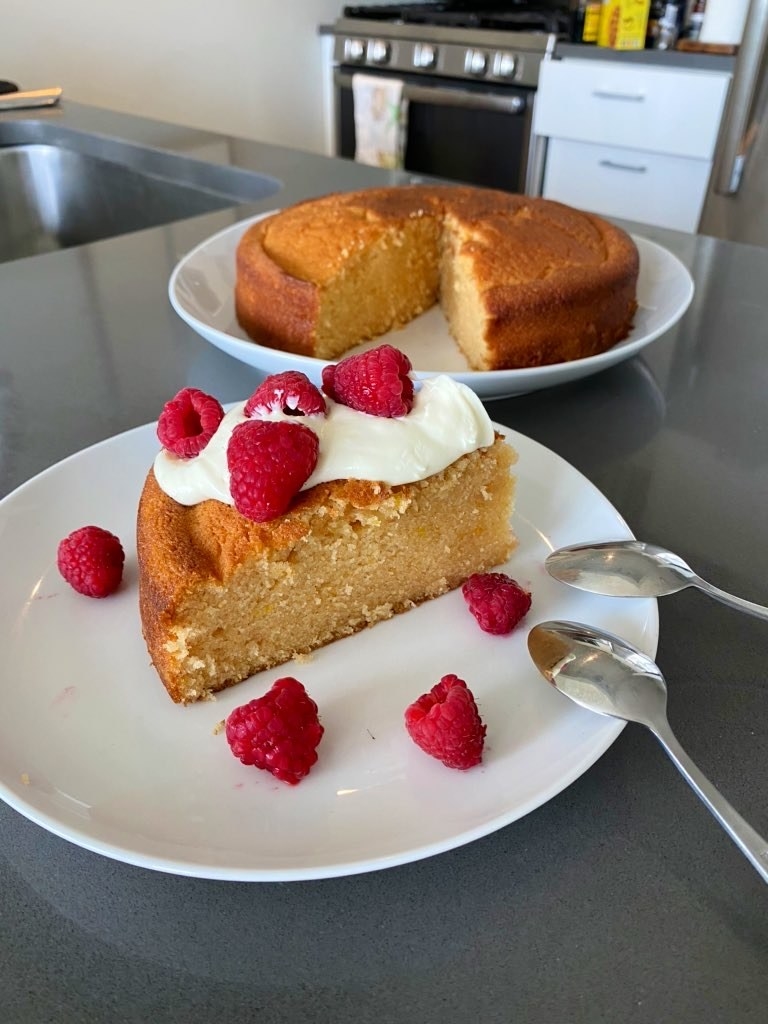
David Mack
Stuck at home with no other real creative outlets, I threw myself into learning to cook better this year. It was something I could do in the evenings to pass the time, certainly, but in all the chaos, it felt nice to set an achievable (and delicious) goal for myself.
Of course, I baked (like everyone else), but I also made things I never could have imagined had they not been served up to me by this delightful little app: French onion grilled cheeses, a skillet tarte tatin, Vietnamese meatballs (made with Ritz crackers!), Thai larb gai, seemingly endless miso chicken (perhaps my favorite easy dish of the year), a salmon curry, a cake made of Campari and olive oil, a peanut butter sandwich served with Sriracha and soy sauce and pickles (which disgusted my Instagram followers until they themselves tried it), a miso pasta with five ingredients, BLT pasta, *that* shallot pasta, and a beef tenderloin with red wine that required one ludicrously expensive trip to a butcher.
There are, of course, a ton of cooking apps to choose from, but I love the way this is curated. It will suggest recipes to you based on what you've made before, but the editors also serve up new ideas for weekly menus. The recipes are easy to follow and are sometimes accompanied by videos. There's also a handy section for cooks just starting out that goes over important basic techniques.
This year was hard, but I did manage to emerge a better cook — and, subsequently, a heavier one — than when I started. —David Mack
6. Strava Routes, $59.99 per year
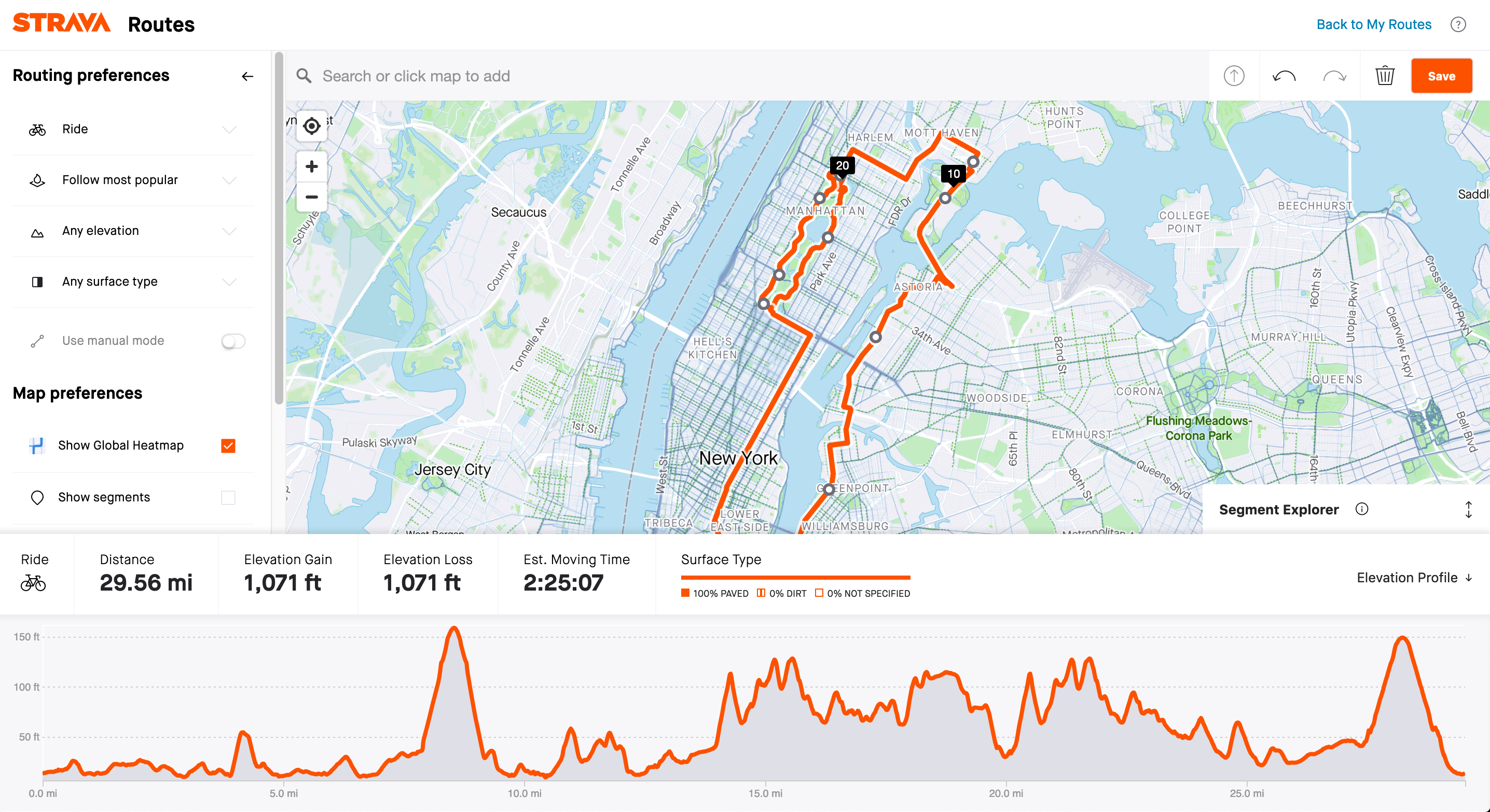
Strava / Logan McDonald
While I've commuted on my bike for years, I was never really interested in riding more than 5 miles at a time (and I had never, ever dreamed of leaving Brooklyn by bike). Like many during the pandemic, however, I turned to my bike for something beyond commuting. From May to November this year, I traveled more than 2,000 miles in the New York City area powered by my legs, my bike, and a crushing sense of impending doom. I planned and shared a majority of that distance through Strava, a fitness-tracking app. Strava has many free features along with premium ones that come with a subscription. One part of Strava premium is my favorite thing in 2020: Strava Routes. Through its app or on the desktop, you can build elaborate trips, either mapping everything down to the block yourself or using their recommendations based on Strava user data of the most popular paths. Routes helped me navigate my rides and share them with friends who joined me or copied them to make their own routes. The route building tool also has helpful features like elevation, distance, and road type indicators to help you avoid having a real bad ride. Biking and planning my routes has been a fantastic way to feel connected with my city, gain a new community, and get into bike safety advocacy.
While I do love Strava Routes, there is one note of caution I need to give. Strava's default privacy settings are awful. Make sure you go through the settings on your account and restrict public access as much as possible. A great guide for how to do that (and generally improve your privacy online) can be found here. —Logan McDonald
7. Bearaby "napper" weighted blanket, $249
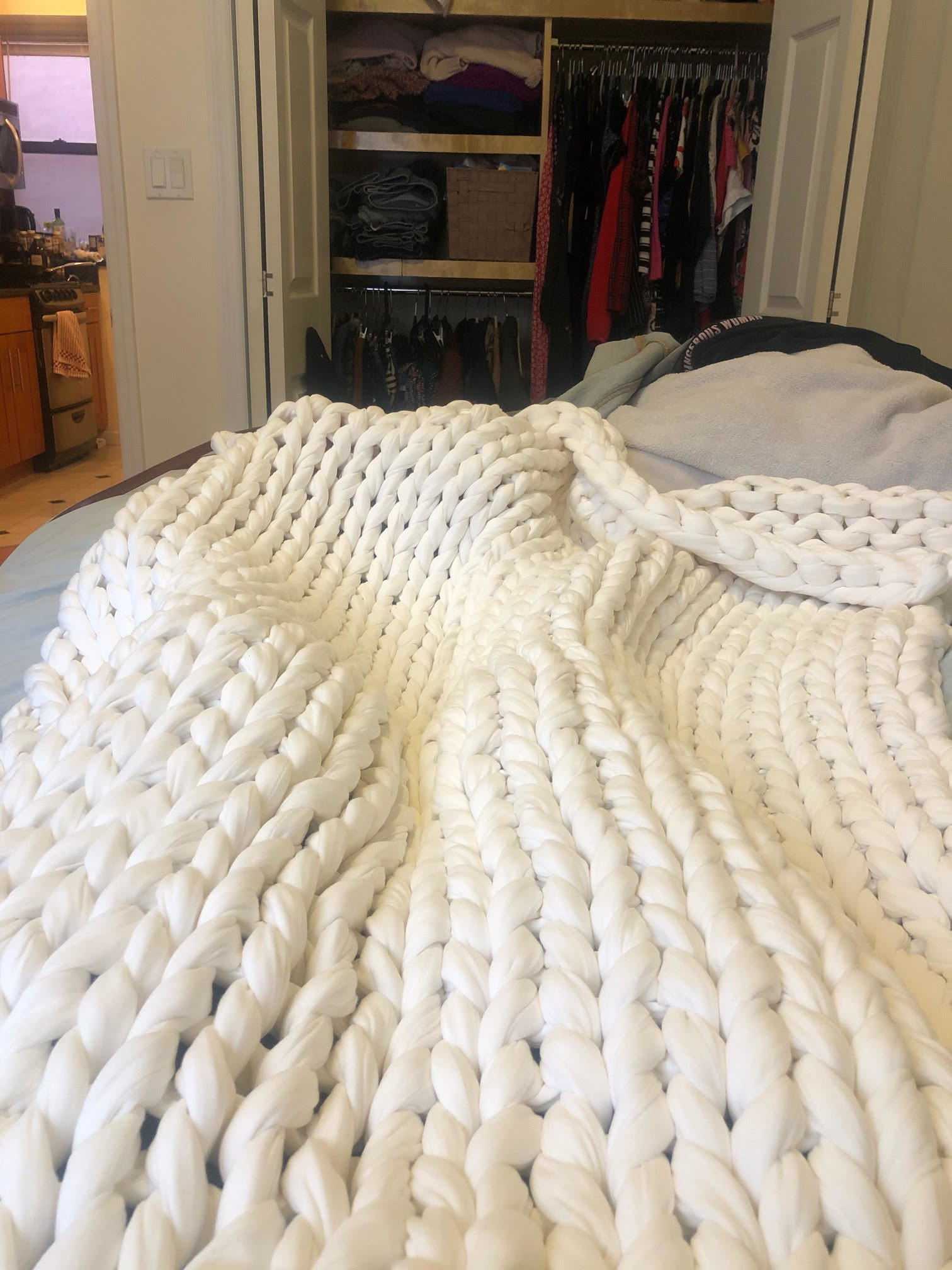
Julia Reinstein
April was, without a doubt, a really rough time in New York — so many people were getting sick and dying, it was frightening just to take a walk outside, and sirens were a near-constant sound. I felt lucky to be safe and healthy, but it took a huge toll on my sleep. I’d lie awake for hours trying to fall asleep, and when I finally managed to, I’d have nightmares and wake up three times a night. That all changed when I bought my Bearaby weighted blanket. I’d wanted a weighted blanket for years (I always loved that soothing feeling when the dentist puts the heavy bib on you 🤤), but desperate to fix my sleeping issues, I finally took the plunge, and I’m so glad I did! It keeps you so nice and cool if you’re a hot sleeper (the main reason I went with this one over other weighted blankets), and since the weight comes from the material itself, not pockets of beads, it doesn’t shift around or make noise throughout the night. Not to mention, it’s beautiful and sustainably made. The Bearaby is not cheap — it cost me $250, more than I’ve spent on anything nonessential, but it was more than worth it to help me sleep again. —Julia Reinstein
8. Olaplex No. 3, $28 at Sephora
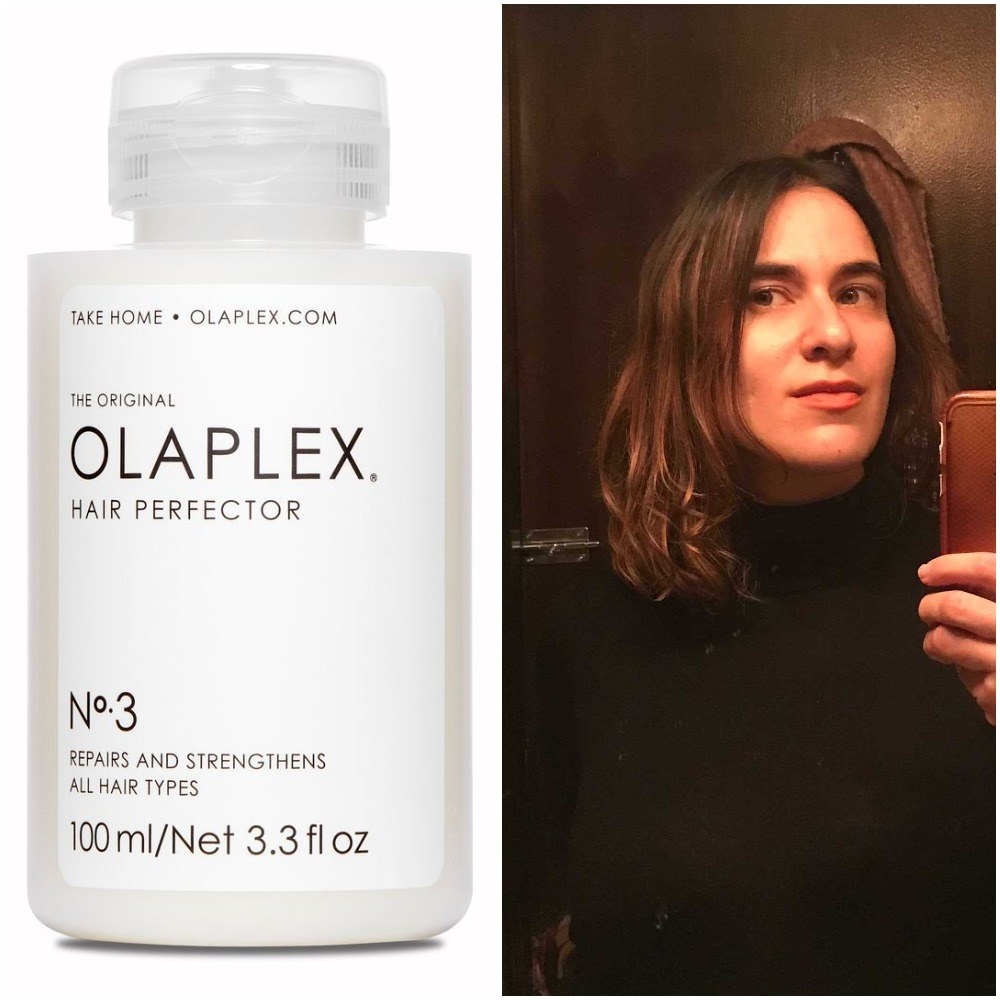
Sara Yasin
I have dumb, fine, oily child hair that is thinning out and damaged from dyeing. For a long time now, I have seen this product touted as a miracle fix for broken, sad hair, but the idea of spending almost $30 on a small hair product seemed like a bit much to me. But the pandemic has meant more time to focus on important things — like how sad Room Rater makes me and how the gaps on my scalp feel. So I decided to give this a try after seeing an influencer who also has polycystic ovary syndrome recommend it. It’s great: Not only did it make my hair feel soft, it also gave it some body, which is usually unachievable if you have the hair of a creepy, Victorian child who haunts the new home of a photogenic white family. Most importantly: It’s helping keep my hair healthy, with fewer breakages. —Sara Yasin
9. Wigs, $18 Blond bob at Shein, $19 “Ginger queen” at Amazon

Caroline Haskins
Wigs are fun, and not just for Halloween!!! Admittedly, I did buy my first wig of this year in preparation for Halloween (in which I was reproducing a highly specific look from a Dua Lipa music video). But as soon as it arrived, I discovered that wigs are super fun to wear around the house for no reason. One might describe it as a "hobby." Since then, I've gotten a few more cheap wigs, including a hot pink bob and long ginger locks. However, I have no upcoming plans to dye my hair. The nice thing about wigs is that you can take them off, look at your natural hair color, and think, Yeah, that makes sense. —Caroline Haskins
10. Growing my own tomatoes, $15 for the tray, $2–$20 for the seeds, both at Amazon
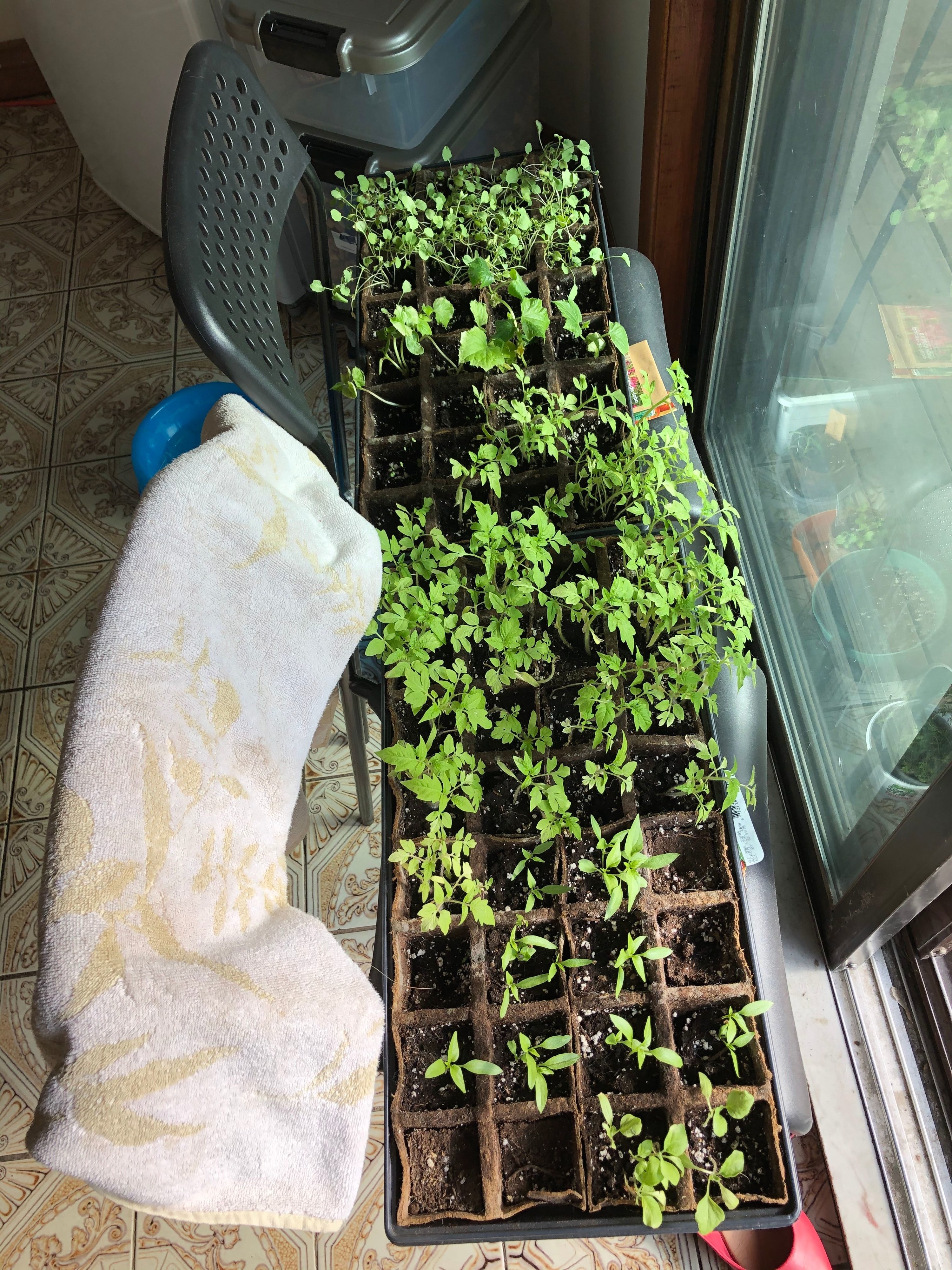
Jane Lytvynenko
Look, I'm not a professional farmer. My grandparents have all had vegetable patches, and when I was little, sneaking fresh veggies from the plants was a joyous pastime. Having sampled hundreds of tomatoes, I can tell you with confidence that buying them instead of growing your own is a crime. I can also tell you that growing your own is easier than it seems. All you need is some seeds (the heirloom variety is obviously superior, but do what feels right) and a seed starter tray filled with dirt.
If you've been blessed with a window that gets direct sunlight, you can forgo the expensive UV lamp setups. The key is to drop a pinch worth of seeds into the dirt, water generously, cover the container with a lid or some cellophane wrap to create the greenhouse effect, and let your future plants be absolutely roasted in the sun for as long as you can manage. This will trick seeds into thinking summer's here and within a week or two they'll sprout, eventually blossoming into real, adult plants. In the middle of lockdown monotony, watching something grow has done wonders for my mental health and has been — by far — the most satisfying product I've tried this pandemic year. And you can eat it, too. —Jane Lytvynenko
11. Mini Complete Pot Grow Kit (1/2 gallon), $40 at A Pot for Pot
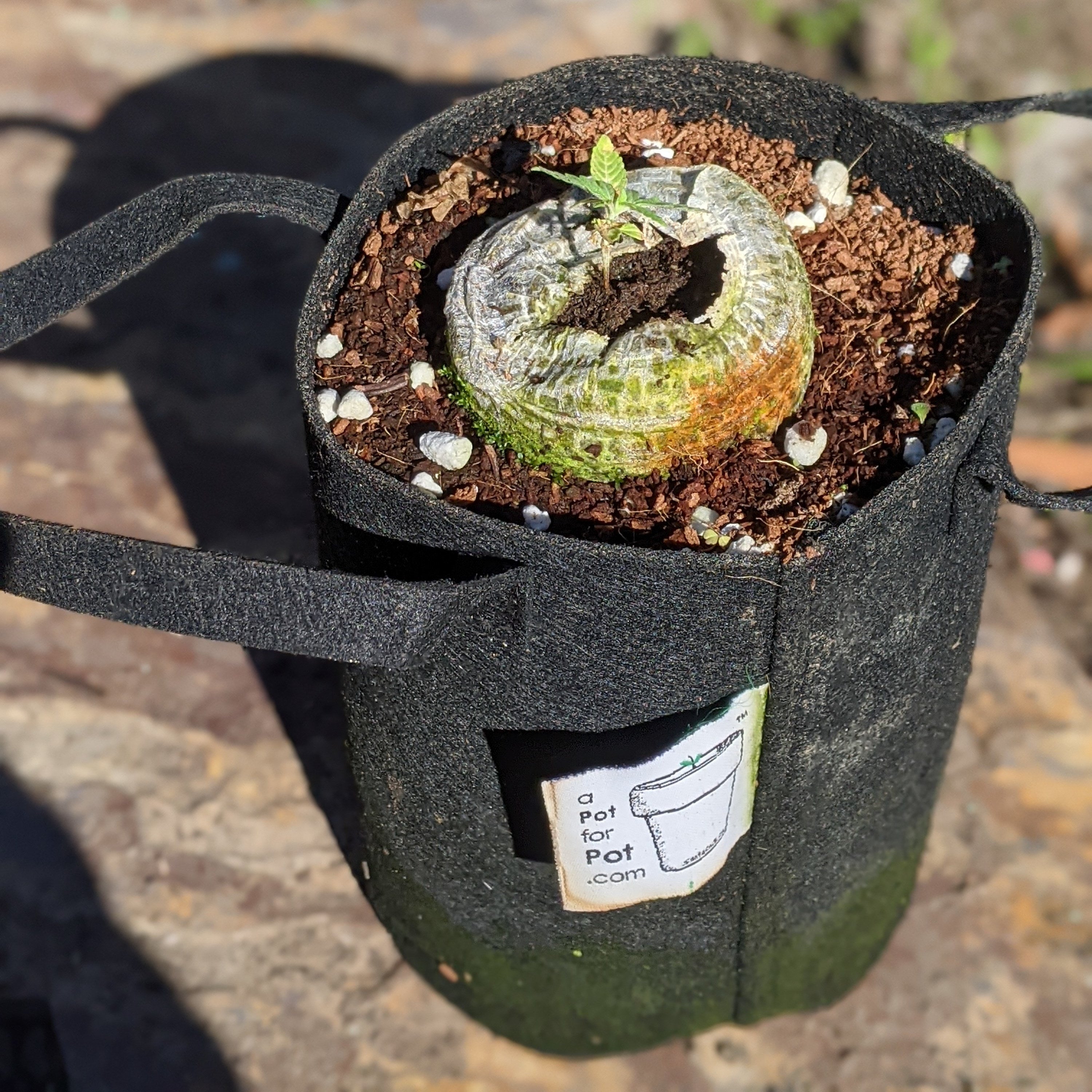
Mat Honan
Remember when the pandemic started and everyone began growing, I don't know, kale? Or did you read the thing about how everyone's gobbling edibles since all this shit went down? Yeah. Look. Combine those two trends and now we're talking.
Cannabis is now legal in states all across this great nation. (Other than super-uptight places like Alabama and New York.) I mean, Oregon, man. Oregon is lit. Jesus. You can just walk into a store and buy it. But why would you buy it in a store when you can grow it in the earth, like our Founding Fathers did. George Washington toked weed, man.
I'll be honest with you, my Mini Complete Pot Grow Kit hasn't yielded any dank purple durple yet, but I only jumped in a few weeks ago. And, even more frankly, the first plant I grew died. But that's because I was growing outside, and some animal ate it. I hope that gopher enjoyed himself. So I'm on round two, and all is well and good.
This little kit has everything you need to grow pot, except pot. You have to buy your weed seeds separately, and these can be pricey. But the kit comes with a $40 coupon you can use at ILoveGrowingMarijuana.com, which is exactly what it sounds like — a place to buy marijuana seeds so you can fulfill your love of growing marijuana.
But everything else? Right here. You've got your soil. Your beneficial bacteria. Your diatomaceous earth. Some cocoa mix. Your fucking...your trimming scissors, man. All that shit. And more too. Basically everything you need, except the seeds. Wait, did I say that already? I think I said that. —Mat Honan
12. Below Deck, all possible seasons and variations, $14.99 season on iTunes, streaming on Peacock app ($4.99 per month) or Bravo
Bravo
When a friend suggested Below Deck as a good, mindless pandemic pastime, I scoffed. I hadn’t watched reality TV in years, and was happily binging on the various Netflix and HBO series; why bother? Then one exquisitely boring Sunday afternoon, my wife popped on an episode of Below Deck: Sailing Yacht. By late Monday evening, we’d finished the entire season. This is saying something, because many Below Deck aficionados would tell you Sailing Yacht is the worst of the franchise (no Captain Sandy). Maybe it is, but I loved it. I was entranced when Jenna had to wrangle an impromptu wedding for two drunk guests; I was eyerollingly enthralled by a catastrophe of social media influencer charter guests; and Georgia's laundry system? Oof. By the time we finished all 18 episodes, we’d renamed the show “Shit Boat” and teed up our first season of Below Deck: Mediterranean. Now, months later, we’ve blown through all possible episodes of the franchise in its many variations, and we eagerly await the newest episode as we would Lovecraft Country and the like. Tuesday night is Shit Boat night. —John Paczkowski
13. PlayStation 5, $499.99 (Currently sold out almost everywhere; check around to find out. Our recs for accessories here.)
Why does the PlayStation 5, the largest console, not simply eat the others?
New video game consoles only come out about every seven years, so they need to feel like a generational leap for years after they're released. Sony's PlayStation 5 can pull that off. With a solid-state drive that loads games almost instantly, 4K graphics, a clean user interface, and a controller with revelatory haptics, it feels like the next generation as soon as I fire it up. The bad news: The PlayStation 5 costs either $400 (with no UHD Blu-ray drive) or $500 (with one), and they're basically impossible to find. The good news: It will still feel next gen even when it's current gen. —Brandon Hardin
14. Group WhatsApp, free, friends not included
When you're getting roasted in the group chat but text back "lol" and act like it's all good.
2020 was the year my group chat became my social life. Waking up (often) exhausted and stressed, I'd inevitably see WhatsApp messages from one of my closest friends, already deep into her shitty day in London. Then the New Yorkers would chime in, then hours later, the Californian. It was a place to be funny about an infuriating and sad year, a place to work out endless uncertainties together, a place to argue over the news in a substantive way that felt worlds away from the flat judgments of social media, a place to share our lunches, our outfits, and our dumb memes. We could live our lives alongside each other, even though we were no longer living our lives alongside anybody. It was constant and transformative, and I loved it. —Azeen Ghorayshi
15. Mortal Kombat 11, Ultimate and Aftermath, $19.99 for Xbox or PS4 at GameStop

Courtesy Warner Bros. Interactive Entertainment
“Was it you that wanted me to kick your ass? I think it was.”
This is but one of the many “invitations” sent to me by my daughters after I rediscovered the Xbox and Mortal Kombat 11 earlier this year. While hardly family-friendly entertainment, Mortal Kombat very quickly became a wonderfully gruesome family hobby for us in the early days of the pandemic. Turns out eviscerating an opponent Leatherface-style with a video game chainsaw is a bizarrely effective way of letting off steam — perhaps the most effective. In fact, I would argue that Mortal Kombat 11 and its new Aftermath expansion pack is the game for the COVID-19 era. That the New York Times declared Animal Crossing “the game for the Coronavirus moment” back in April is immaterial, as the Times is so ferociously wrong here. When you’ve been sheltering in place for months under a quarantine order, do you really want to watch some dopey beaver buying party poppers at Nook’s Cranny? Or do you want to see Rambo dispatched in a comedic explosion of innards by a woman with four arms? The choice is pretty clear. —John Paczkowski
16. Noom app, two-week free trial, six months for $159

Noom / Craig Silverman
Around 15 years ago my 6-foot frame carried 234 pounds. I got a trainer, took food and portions seriously, and lost 40 pounds. Since then, I’ve eaten paleo, followed the Zone Diet, tried intermittent fasting, took up boxing and CrossFit, and been a member of many gyms and yoga studios. The pounds stayed off, but I’ve searched for a way to unlock the next level of health and weight loss. In August, I downloaded Noom.
It has the usual features of a health app, including a weight tracker, step counter, and activity log. It nudges you toward healthy habits using content about food, behavioral triggers, and nutrition, and offers access to a coach and small group of other Noomers. My revelation was the food log, where I enter what I eat and see how it matches up to my daily calorie budget. Just by tweaking what I eat using Noom’s green/yellow/red food quality guide and calorie tracking, the pounds began melting away. I lost 20 pounds in just over two months. —Craig Silverman
17. Seth Skorkowsky’s YouTube channel
View this video on YouTube
A batch of pandemic Zoom chats with high school buddies this spring triggered nostalgic Dungeons & Dragons memories of rolling dice, making jokes, and murdering stuff, one of the more wholesome ways I wasted my adolescence. For a fix, I turned to Seth Skorkowsky, a science fiction writer who reviews role-playing games on YouTube, stretching the boundaries of green-screening replays of amusing game screwups in his recaps. The reviews are actually little sitcoms with recurring characters he plays himself in idiotic costumes, vignettes that present a picture of a happier world where people own dragon-castle-shaped dice-rolling boxes and entertain themselves by figuring out how to loot Cthulhu's minions. There are plenty of in-jokes, and Skorkowsky's rather adult but always self-mocking reviews of adventures gone wrong are a balm after a bad day and still short enough to still get to bed on time for the aging former gamer. —Dan Vergano
18. Google Photos, storage plans start at $1.99/month up to $49.99/month
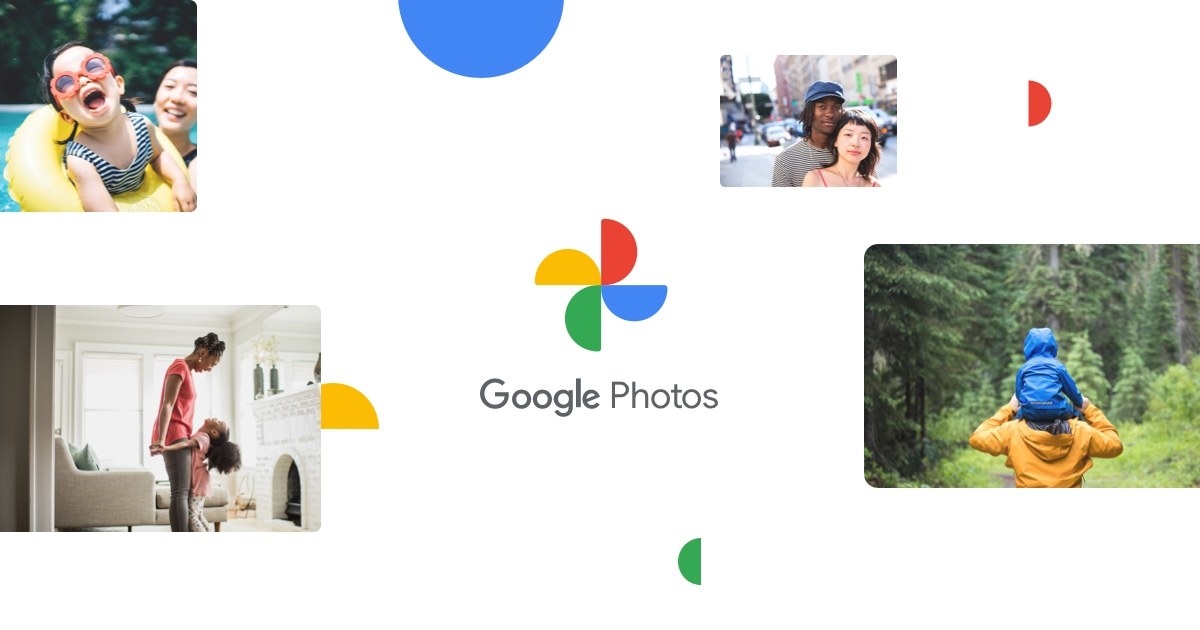
Google Photos
Countless times during this year from hell, I’ve spent hours basking in the nostalgia of happier times: a vacation to Bali in 2019 (remember vacations?), a birthday party from 2018 (remember parties?), and an offsite in San Francisco with colleagues in 2017 (remember colleagues?).
I owe this to Google’s largesse. For the last five years, the company’s Photos app has been sucking up my memories — every picture and video taken from my phone, 42,701 and counting — and storing them securely on Google’s servers. In exchange, I, like millions of people around the world, agreed to let Google mine my life to train its systems to recognize pretty much anything and anyone.
Between days of feverish doomscrolling, Google Photos served as a welcome distraction, where each scroll served up a happy memory, a reminder of a life lived free of masks, a time when we hugged, and laughed, and kissed, and when authoritarian despots didn’t rule the world. A happy little chime each morning announced the arrival of yet another notification that whisked me away to a time and a place that was…not this. When I was racked by anxiety, as so many of us were this year, Google Photos became the private island I could retreat to for endless stretches of time.
If you don’t already use Google Photos, I encourage you to sign up immediately. It’s the best way to permanently back up your photos and videos, even if the free ride is coming to an end. Earlier this month, Google announced that storing your memories would no longer be unlimited after June 2021. You will, instead, need to pay at least a couple of dollars each month once you bump up against a storage limit.
And if you already use the service, you don’t need me to convince you to pay up next year if you need to and stick with it. A lifetime of memories ready to dip into whenever the mood strikes is priceless. —Pranav Dixit
19. A T-shirt made of crabs, $48 from Allbirds
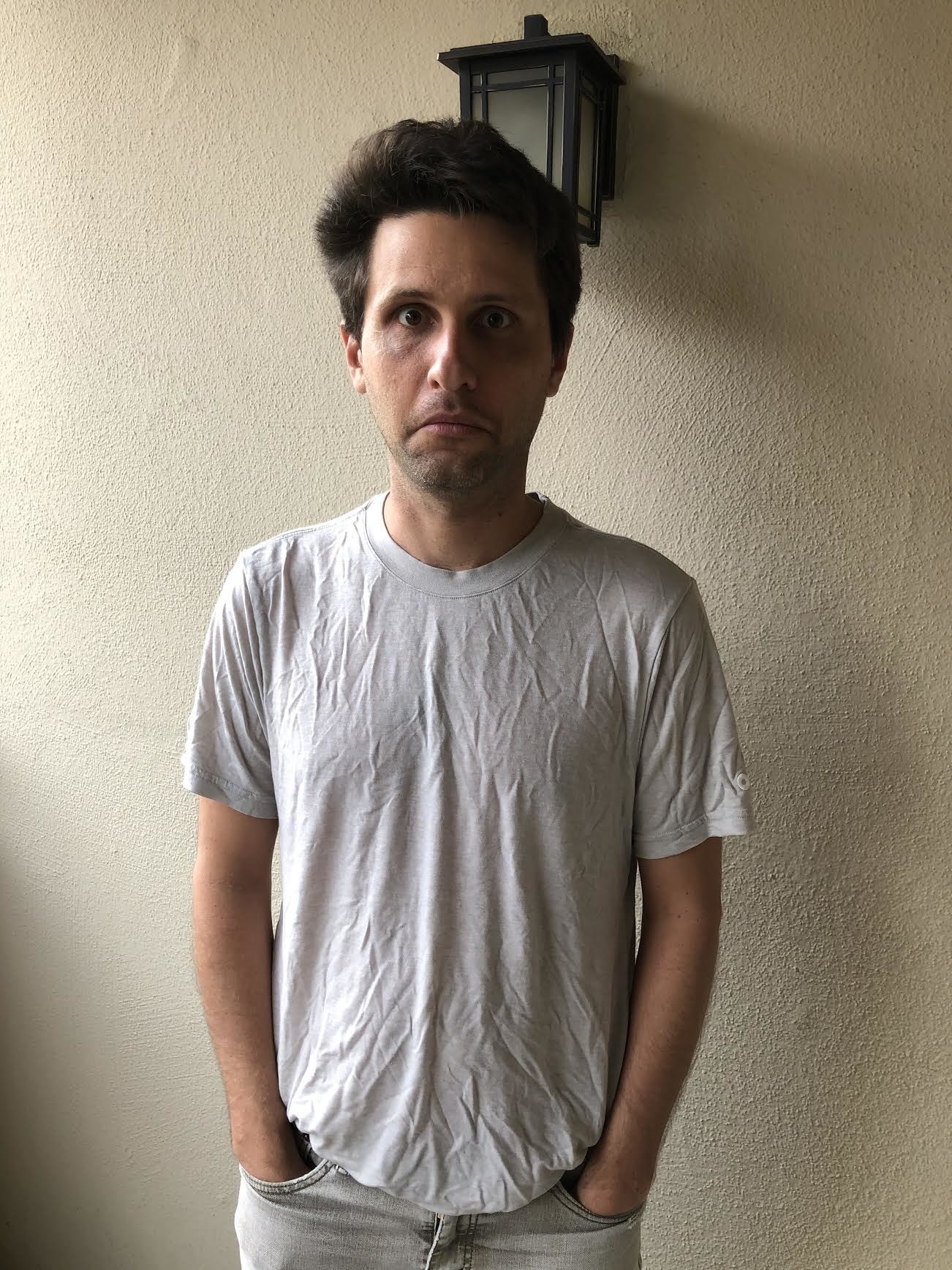
Scott Lucas
There are few things in life that give me more joy than direct-to-consumer basics, neutral colors, strange materials, and crabs. So when shoe company Allbirds announced the TrinoXO™ Tee, which it says is made from “revolutionary natural materials like crab shells,” I immediately bought one. Do I understand what alchemy is at work here? No, not in the slightest. But my crab shirt, which I wear weekly, is cool to the touch, wrinkly the way I like it, and totally indistinguishable from a cotton one. It's perfect for all my T-shirt needs, including sitting quietly, pacing, and fretting. Except that it cost $48 before shipping, is made of crab shells, and I love it. —Scott Lucas
20. Tile for my cat, $17.99 at Amazon

Ryan Mac
My cat’s name is Cricket. She is the loveliest, most pampered 5-year-old tortoiseshell on the face of the earth. Look at her. What the absolute hell. I can’t believe any animal can be this sweet. I love her.
When I’m at home, I let Cricket go into the backyard during the day, which is by far her favorite activity. Being the ever-curious cat though, she sometimes gets lost, climbing into bushes or wandering out the front gate. Since I’ve been working from home more, she’s been able to go outside more — and as a result, has gotten lost more.
To prevent a permanently lost cat and permanently sad me, I turned to a technological solution that my boss Mat Honan used on his kids. Tired of them losing their winter jackets, Mat put a Tile — one of those Bluetooth-connected key finders — on their more expensive clothes, helping him find wherever they left them at home, school, or wherever.
Just as Mat tiled his kids, I’ve tiled Cricket, who looks cute as hell with her white square on her collar. It’s great for when she’s not within eyesight, and she’s even trained herself to come back inside when I trigger it to ring. It’s not a complete location tracker — the device won’t ring if it’s out of the Bluetooth range of your phone — but it does provide that extra sense of security. Anything for this damn cat. —Ryan Mac
21. PRW+ laptop stand that adjusts to standing height, $54.90 at Amazon
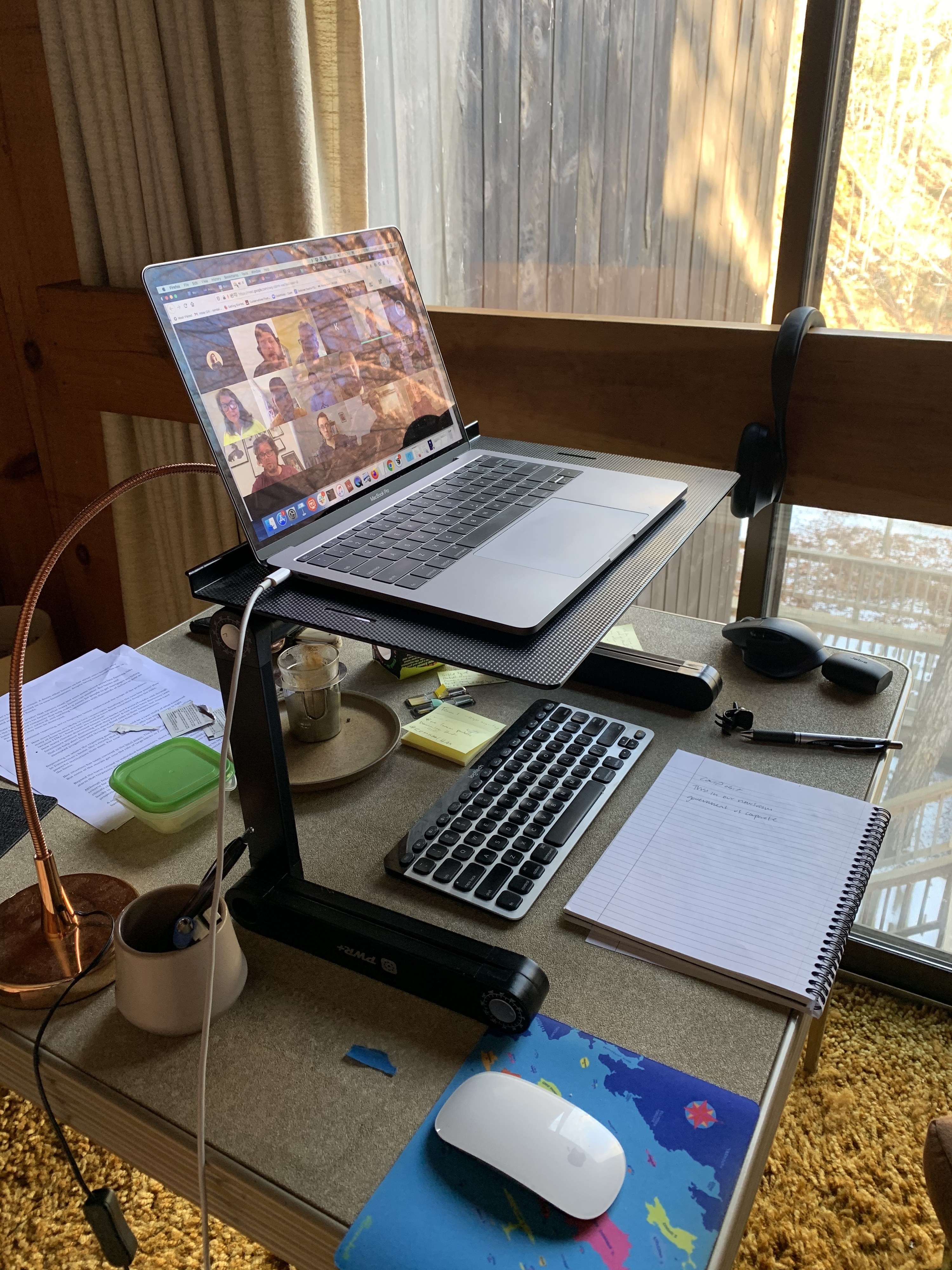
Kendall Taggart
This computer stand that easily converts into a standing desk makes long days connected to the world through my laptop a tiny bit better. I still slouch constantly but 🤷🏼♀️. —Kendall Taggart
22. Maven digital clinic, $20–$70 per appointment (or free as an employer benefit)
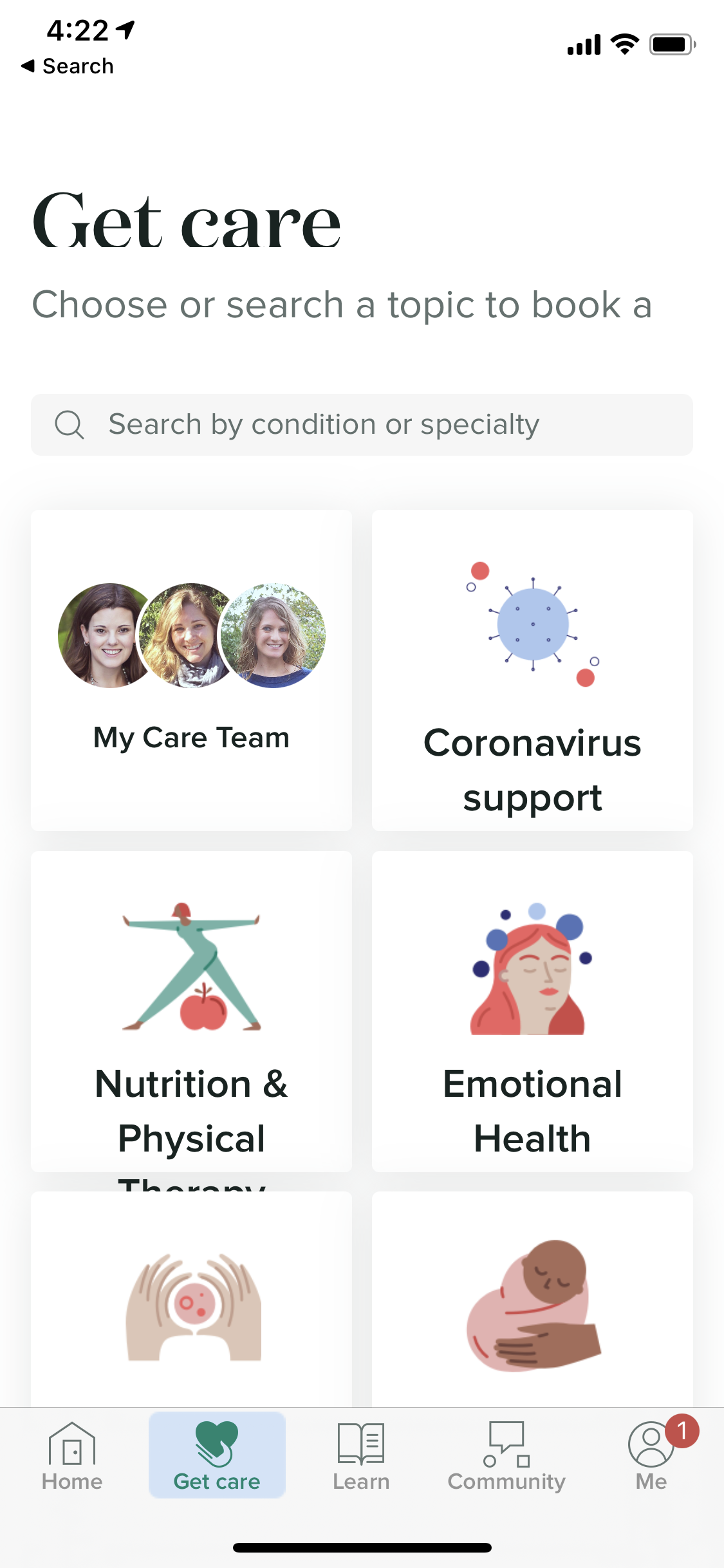
Maven
Maven is a telemedicine service for fertility, pregnancy, postpartum, and family health. It’s not tied to your insurance and wouldn’t replace your actual OB-GYN or pediatrician, but it offers a slew of other services like pediatric sleep coaches, therapists, physical therapists, and career coaches that would normally be more expensive and more difficult to see in person.
Anyone can sign up and pay à la carte for sessions with a lactation consultant or pelvic floor therapist, but Maven’s real business is marketing itself to companies to make it one of their extra employee benefits. The pitch is that if your pregnant employees use this, they’ll have an easier experience and will be less likely to drop out of the workforce or need to take time off work to go to doctor’s appointments. The Maven site boasts a 90% return-to-work rate and that 58% of their users are more productive at work (unclear how that’s measured) and 36% are able to avoid doctor’s or ER visits. For healthcare plans, Maven claims lower C-section and NICU rates. Make no mistake, workers: Your employer cares about your physical and mental health because they want to keep their costs down.
I had my second child this spring, near the peak surge, and the video chat model made way more sense. I couldn’t have a doula in the delivery room, so I took advantage of a free chat with one beforehand.
From there, I was off and running. Suspected thrush on a weekend when the pediatrician’s office was closed? Did a video chat with a nurse/lactation consultant who specializes in fungal infections. (It wasn’t thrush!) Bedtime became a living nightmare with my older child? Videochatted a sleep consultant who recommended moving his bedtime earlier. (It worked!) Wanted to sleep train the baby? Another sleep consultant. (Worked again!) Potty training help for older kid? Occupational therapist video chat. (Didn’t work, but not her fault.) Weird pain in my shoulder that isn’t even baby-related? Fuck it, video chat a physical therapist. (Turns out eight months of zero exercise is not good on the body. She gave me a list of arm exercises to do.)
Having a newborn is an isolating experience — trapped at home in a bubble with little sleep and a total disruption of your former life — and the pandemic really doubled down on that. I was absolutely happy to take advantage of a free service that was going to help me in any way possible. I’m not sure I’d PAY for it (although if you use nothing else, the sleep consultant chats are far cheaper than you’d typically pay), but as a free benefit through my employer, it was A+.
One note on privacy: After a Washington Post story last year about an employer-sponsored pregnancy tracker app that shared data with employers, I asked Maven about what data it shares. It does not share anything except the total number of employees who have signed up to use the app. —Katie Notopoulos
23. Find What Feels Good — the Yoga With Adriene app, $99 per year or $9.99 per month
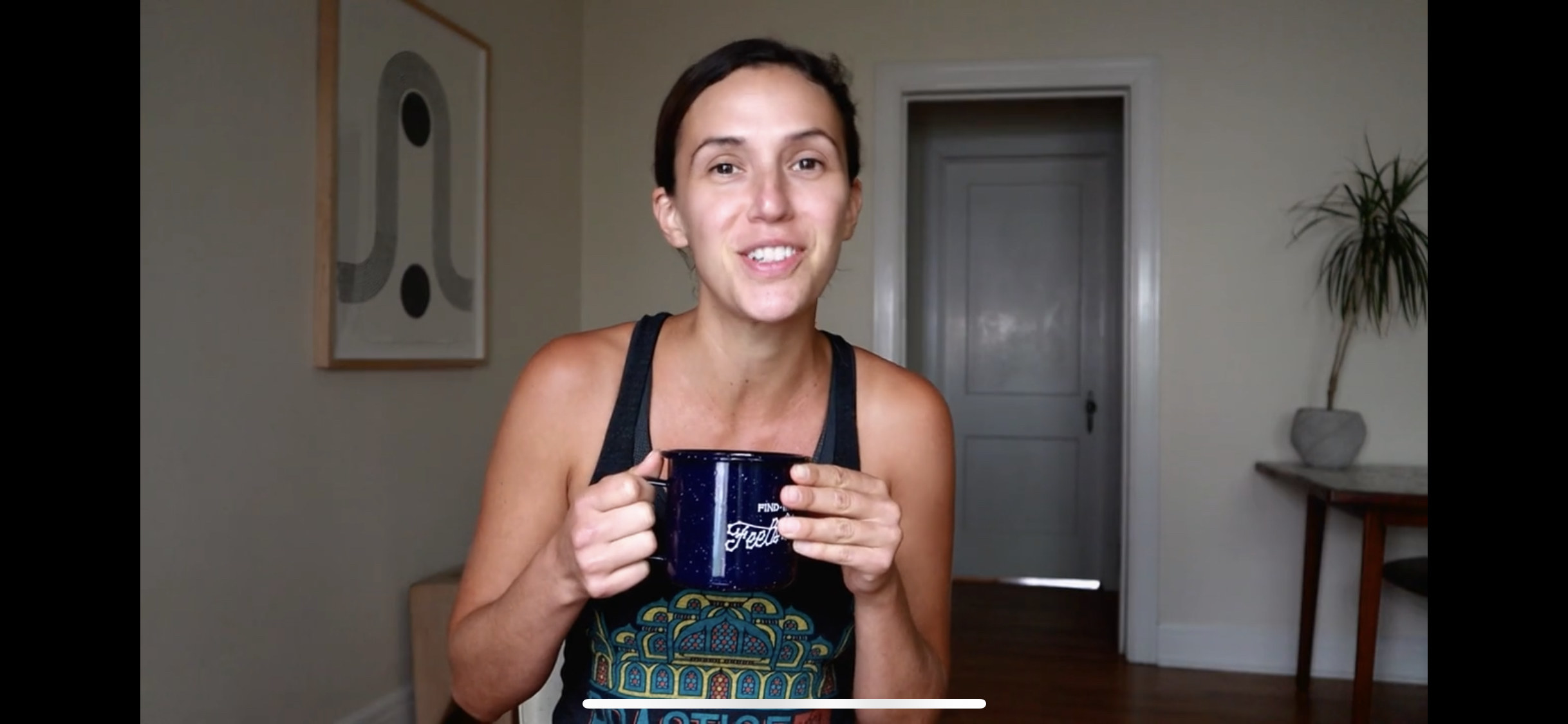
Yoga With Adriene
I did my first Yoga With Adriene class on March 19, right as the absolute terror of the pandemic hit. Adriene Mishler, a peppy Texan who records all her yoga videos next to her old kelpie Benji, told dumb jokes and talked me through a gentle workout despite my body feeling like it could crack entirely at any moment.
Since then I’ve done around 150 of her classes — such as “Yoga for Tension Relief” and “Yoga to Feel Your Best” — which are all free on YouTube. I'm not alone — she rightly rose to quarantine guru fame helping people to “find what feels good” at a time when everything feels bad, very bad.
One evening in November, just as I rolled my mat out and put on comfy clothes, I found YouTube was down. But it was day four of my latest 30-day yoga challenge!
It was finally time to buy Adriene's app Find What Feels Good. She doesn't push it hard at all — I didn't even know it existed until another YWA-devoted pal mentioned it. The app is nicely designed and has all her videos as well as a charming monthly members-only vlog where Adriene sips tea, says calming things, and even reads some poetry.
Members get some other benefits, but really the main one is avoiding YouTube. In a time when I feel even more conscious of which companies and people get my money, it feels nice to give money directly to someone whose work helps me daily — and has given me tiny abs! — rather than watching ads so they can get paid. —Amber Jamieson
24. Slinky, $6.99 at Amazon
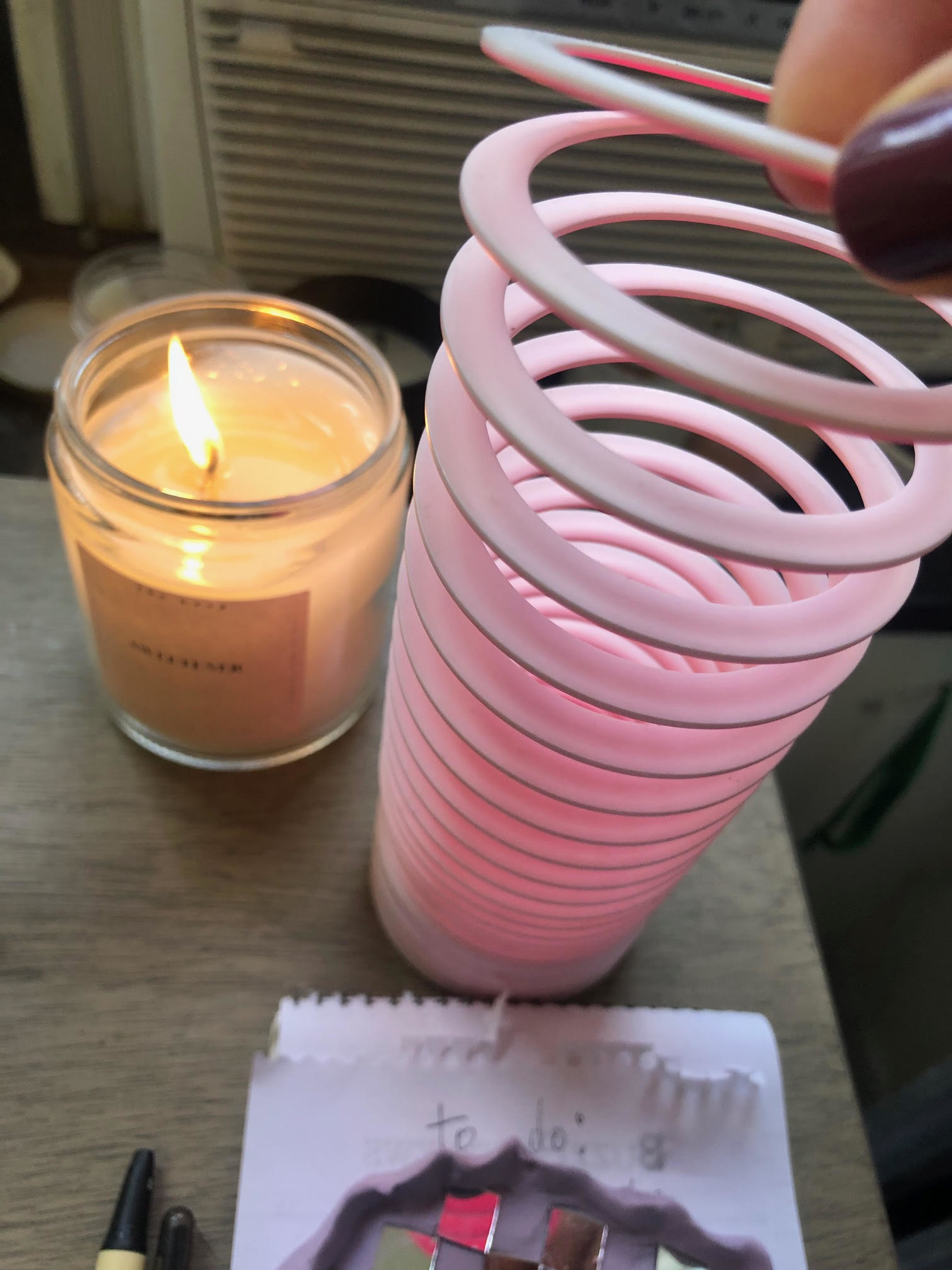
Julia Reinstein
I would really like to have a word with everyone who was writing those “Is This the End of the Office?” thinkpieces in the beginning of the pandemic. I hate working from home and am so looking forward to getting back to the office once it’s safe! Staying focused while working from home has not been easy for me, and it’s taken a long time and a lot of work to adjust. One of the best little things I did to help with this? I started keeping a Slinky on my desk. Most of the time, it sits on the corner of my desk like a little pink plastic objet d’art, usually with my tube of Weleda Skin Food (also recommended) sitting in its center. But when I’m feeling anxious or restless and need something to fidget with, my Slinky is there, ready to be wiggled and bounced around and made a little noise with. I have fully played with it on long Zoom calls, and as long as you’re on mute and keep it low down enough, no one will be the wiser. —Julia Reinstein
25. The Book Bundler, $15–$20+ per box of 20 used kids books

One of the worst pains of the pandemic for me (other than, you know, ~all this~) has been the closure of the public library. My preschooler mows through books at bedtime, and if the books are repeated too often, he gets bored and the situation quickly devolves into Bedtime War.
Normally, I’d go once a week to grab a big stack of books, just pulling whatever off the shelves that seemed age appropriate.
Now the library branch near to me is closed completely to the public. A branch farther away is open for pickup of reserved books only, but there’s a 10-book limit on holds and you have to know exactly the name of the book you want — and for kids books, that doesn’t really work.
Buying new books at full or discounted Amazon prices, at least at the quantity I need, isn’t a reasonable option at all.
I learned about Book Bundler from the Facebook Group for fans of the Gee Thanks, Just Bought It podcast, and immediately bought four different bundles. It comes out to around $1 a book for a thematic bundle of used books, less if you buy even more. I bought a 20-book bundle of the leveled readers and some other paperbacks and hardcovers. I’m sure they’re not all great, but I need quantity over quality! There are thematic or author bundles for various ages: a Goosebumps box, Diary of a Wimpy Kid, board books for babies, Little Golden Ones, etc.
I look forward to my local library reopening because the branches serve the public in lots of ways more than just free books. But for now, this’ll do. —Katie Notopoulos
26. Instagram AR filters

Caroline O'Donovan
I live on the opposite side of the country from my parents, which because of the coronavirus pandemic I haven’t seen my dad in almost a year. I did send him a video message the other day, though, except instead of me talking it was an image of me as a glowing green dragon head wearing lipstick talking.
“Omg. That is great! It looks so real. I am gonna have nightmares,” he said, before asking me if the effect was created by colored contact lenses.
Small moments of delight have held many of us, myself included, together this year as though by chewing gum. And few technological sleights of hand have brought more joy than Augmented Reality (AR) filters (I am partial to Instagram, but it’s the individual designers and not the platform, in my opinion, that matters.)
To use Instagram filters, make sure your app is up to date, go to the home page and swipe right. Arrayed along the bottom of the screen where you make a Story post should be small circles, each of which represent a filter. Some are insipid (puppy ears), some are vain (there are infinite eye-widening and skin-clearing options), but just as many are bizarre, hilarious, freaky, and fun. Some are even games!
I spent much of the early weeks of quarantine exploring these filters and if you want to enjoy them, I suggest you do some exploring too. My taste, to my mother’s chagrin, runs toward the eerie and disgusting, and some of my favorite AR designers who share filters to the app are @marcwakefieldarts, @jqgray, @arabskiy.skakun, @solar.w, @anonamister, and @mitsukokubota. To find them, or to search by keyword, open any filter, click on “Browse Effects” and use the magnifying glass icon in the upper right corner to search. (You can also start by browsing the Effect Gallery, where categories include “Moods”, “Weird & Scary” and “Games.”) It’s up to you whether you want to post videos to your story or download them for your own offline purposes.
I like how sometimes a technology that seems silly or pointless can surprise us. Once I explained the AR filters to my dad (who does not know what Instagram is), I asked if he had any requests. He said Tasmanian Devil, and Chewbacca, and I was happy — no, delighted — to oblige. –Caroline O'Donovan
Recommend
About Joyk
Aggregate valuable and interesting links.
Joyk means Joy of geeK